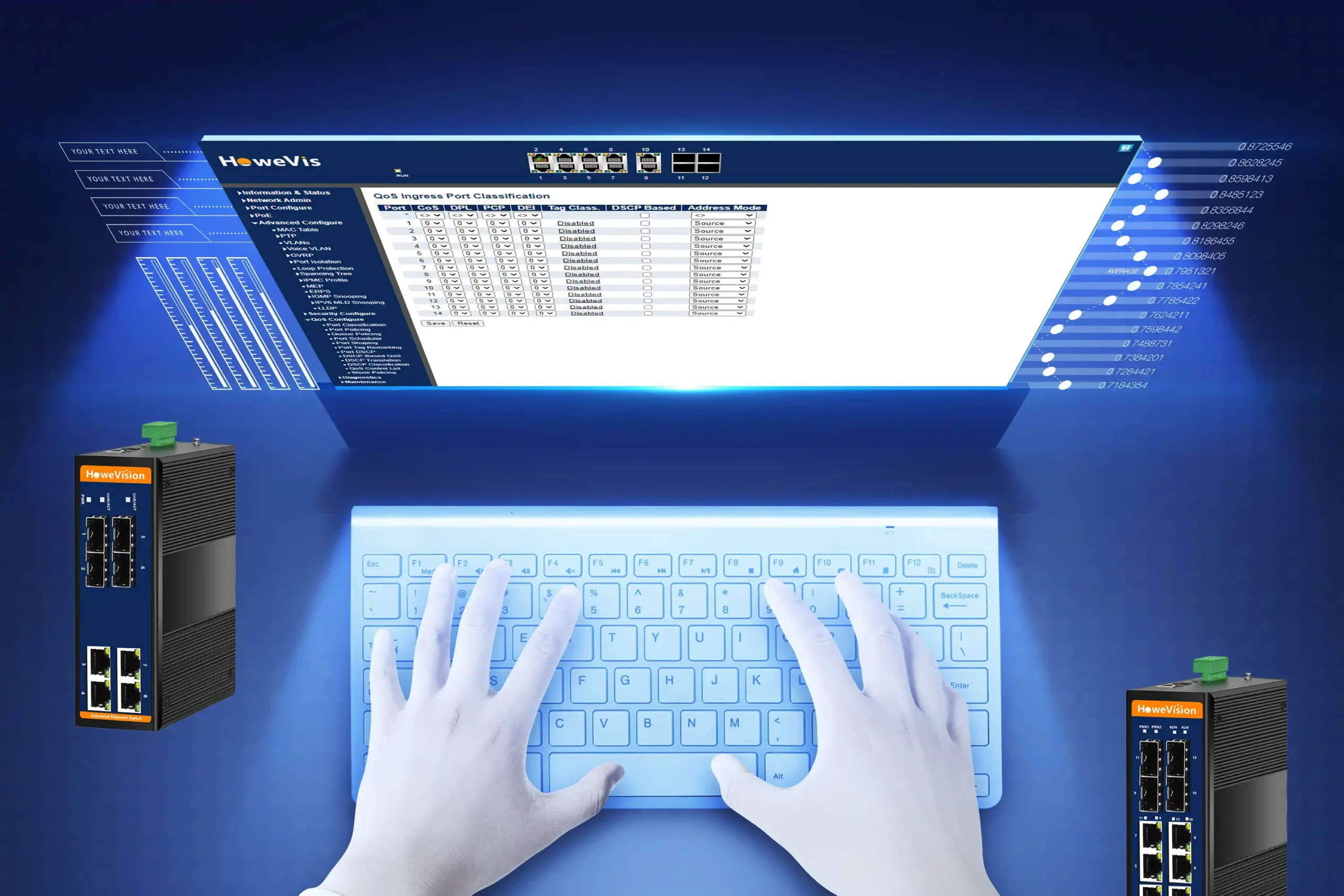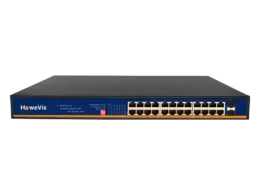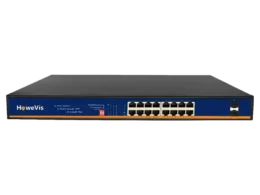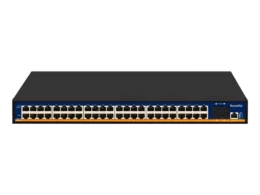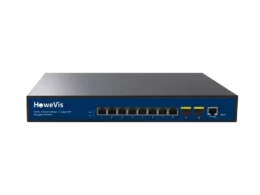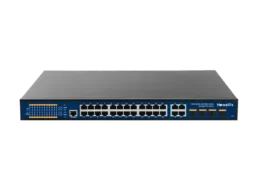Unlock network efficiency with our managed PoE switch. Maximize power over Ethernet capabilities for your devices. Experience the difference now!
Managed PoE switches have become indispensable in modern network infrastructure. These switches provide power and data connectivity and offer greater control and flexibility to the network administrators. With the ability to manage the networks efficiently, we can ensure seamless operations and optimal performance for all connected devices.
In today’s fast-paced digital landscape, the historical context of these managed PoE switches underscores their significance. As technology continues to advance, our reliance on these devices grows exponentially. They represent a pivotal point in the evolution of networking equipment, streamlining processes while enhancing productivity.
Unveiling Power over Ethernet Technology
Simplifying Installation
The technology plays a pivotal role in simplifying installation processes. Power over Ethernet (PoE) can transmit power and data through a single Ethernet cable. This eliminates the need for separate power cables, making the setup more streamlined and cost-effective.
The simplicity of installation is particularly beneficial in scenarios where multiple devices need to be powered and connected via Ethernet simultaneously. For instance, managing PoE switches significantly reduces clutter and enhances overall efficiency in an office environment with numerous IP cameras or wireless access points.
In addition to reducing physical clutter, managed PoE switches also contribute to a cleaner network design by consolidating power sources. By centralizing power delivery through the switch infrastructure, organizations can control their networks more while maintaining a tidy and organized setup.
Varied Applications
Managed PoE switches find extensive use across various applications such as surveillance systems, wireless infrastructure deployments, Voice over Internet Protocol (VoIP) telephony setups, and many others. For example:
| Surveillance systems: | IP cameras are often powered using PoE technology. This simplifies their installation and ensures continuous operation even during power outages. |
| Wireless infrastructure: | Access points with Wi-Fi connectivity can be conveniently powered using managed PoE switches without requiring additional electrical outlets near each device. |
| VoIP telephony: | Many modern VoIP phones support Power over Ethernet for streamlined deployment within office environments. |
The versatility of managed PoE switches makes them indispensable in modern networking setups where efficiency and flexibility are paramount.
The Importance of Managed PoE Switches in Networks
Enhanced Network Control
These devices offer advanced features such as VLANs, QoS, and SNMP management. These capabilities provide us with enhanced control over our network infrastructure. With VLAN support, we can logically segment the network into different virtual networks, improving security and efficiency.
Furthermore, Quality of Service (QoS) ensures that critical applications receive the bandwidth and priority required for optimal performance. This means we can prioritize voice or video traffic over less time-sensitive data to maintain a smooth operation. Simple Network Management Protocol (SNMP) functionality enables comprehensive monitoring and management of network devices from a centralized location. We can quickly identify issues and proactively address them before they escalate.
In addition to this extensive control, managed PoE switches empower us with the ability to manage connected devices remotely. Whether at home or away from the office, these switches allow us to troubleshoot problems without physically being present at the site where the issue occurs.

Centralized Security Management
Using managed PoE switches significantly enhances our network’s security through centralized control mechanisms. By leveraging VLANs on these switches, we have control over who has access to specific parts of our network infrastructure. For instance, we can minimize potential security risks associated with unauthorized access attempts by segregating guest Wi-Fi traffic from internal corporate data traffic using separate VLANs.
Moreover, given that managed PoE switches enable remote device management capabilities via SNMP protocols mentioned earlier on top of other built-in security features like Access Control Lists (ACLs), encryption protocols like SSH/SSL/TLS for secure remote connections are also available for an added layer of protection against unauthorized access attempts.
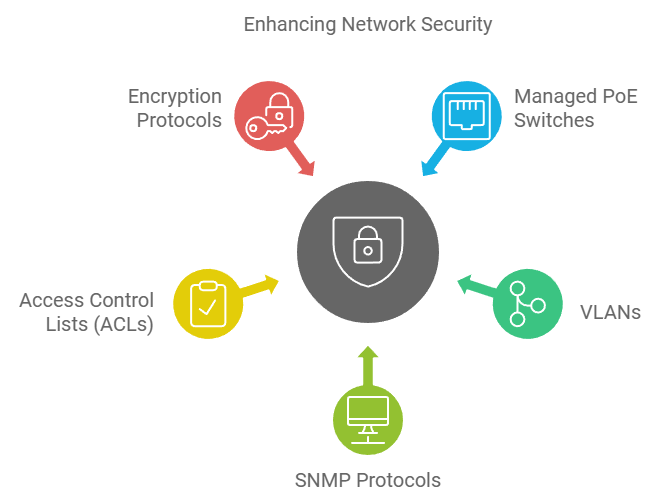
Key Features of HoweVision Managed PoE Switches
Port Mirroring
Port mirroring is a valuable feature offered by HoweVision managed PoE switches. It allows us to monitor the network traffic passing through one port and replicate it to another, enabling efficient network analysis and troubleshooting without disrupting regular data flow.
This feature is handy when we need to diagnose and resolve network issues without interrupting the regular operation of the systems. For example, suppose we suspect that a particular device or port is causing disruptions in the network. In that case, we can use port mirroring to capture and analyze its traffic for potential problems.
IGMP Snooping
Another essential capability of HoweVision managed PoE switches is IGMP snooping, which enhances the efficiency of multicast transmissions within our network. With IGMP snooping, the switch intelligently works multicast traffic by forwarding it only to the ports where such traffic has been specifically requested.
By implementing this feature, we can prevent unnecessary flooding of multicast packets across all ports, thereby conserving bandwidth and optimizing network performance. This becomes especially crucial when streaming media or real-time video applications rely on efficient multicast delivery.
Spanning Tree Protocol (STP)
Including Spanning Tree Protocol (STP) HoweVision managed PoE switches contributes significantly to maintaining a stable and resilient network infrastructure. STP helps us avoid loops in interconnected switches by identifying redundant paths and blocking them while keeping an active path for data transmission.
In practical terms, STP ensures that there’s always an alternate path available if any part of our primary network connection fails due to hardware issues or cable faults. This safeguards against downtime caused by single points of failure within our networking environment.
Gigabit Ethernet Ports
Our experience with HoweVision managed PoE switches has highlighted their support for high-speed data transmission through Gigabit Ethernet ports. These ports deliver exceptional performance by facilitating rapid data transfer rates suitable for demanding applications such as high-definition video streaming, large file transfers, and other bandwidth-intensive tasks.
Gigabit Ethernet technology enables us to maintain seamless connectivity while accommodating the escalating demands placed on modern networks. Whether supporting multiple devices simultaneously or handling substantial data traffic, these high-speed ports ensure reliable performance across diverse operational requirements.
The Advantages of Using HoweVision Managed PoE Switches

Seamless Power Delivery
We all know how frustrating it is when devices experience downtime due to power issues. With managed PoE switches from HoweVision, we ensure seamless power delivery to connected devices. This means no more disruptions or productivity loss caused by power outages.
HoweVision’s managed PoE switches are designed to deliver consistent and reliable power to various devices, including IP cameras, wireless access points, and VoIP phones. By integrating data and power over a single Ethernet cable, these switches simplify network infrastructure deployment while maintaining uninterrupted operation for critical applications.
The ability to remotely monitor and manage the power consumption of each connected device allows us to proactively address any potential issues before they escalate into significant problems. This proactive approach helps us maintain a stable and efficient network environment without unexpected interruptions.
Extensive Scalability Options
As network requirements continue to grow with the expansion of a business or organization, it’s crucial that our networking equipment can keep up with this growth. HoweVision’s managed PoE switches offer extensive scalability options that allow us to expand our network infrastructure without overhauling the entire system.
Whether we need additional ports for new devices or increased bandwidth capacity for higher data traffic, these switches provide flexible expansion capabilities. We can seamlessly add more PoE-enabled devices as needed without worrying about compatibility issues or performance bottlenecks.
For example, if we decide to install more security cameras across our premises or integrate IoT (Internet of Things) devices into our network ecosystem in the future, having scalable managed PoE switches ensures that we can accommodate these changes effortlessly while maintaining optimal performance levels throughout the entire network.
Advanced Management Features
Efficient resource allocation is essential in optimizing network performance and ensuring critical applications receive priority treatment when necessary. HoweVision’s managed PoE switches have advanced management features that enable us to allocate resources effectively based on specific requirements.
These advanced management capabilities include Quality of Service (QoS) prioritization, VLAN segmentation for enhanced security and traffic isolation, and remote monitoring and configuration through intuitive management interfaces. With these features at our disposal, we have greater control over how resources are utilized within our network environment — ultimately leading to improved overall performance and user experience for everyone accessing the network resources.
How Managed PoE Switches Empower Connected Devices
Enhancing Device Performance
We are talking about advanced power management capabilities that can truly optimize the performance of the connected devices. These switches provide power and offer intelligent control and monitoring features. For example, they enable us to remotely reset or shut down specific ports, helping us troubleshoot issues without physically accessing the device.
Managed PoE switches support automatic device discovery and configuration. When we connect a new device to the network, the switch can automatically detect it and apply pre-defined settings for seamless integration. This hassle-free deployment saves us time and effort while ensuring that all connected devices operate efficiently within our network.
Enhanced Security and Network Prioritization
With managed PoE switches, we gain access to enhanced security features such as access control lists (ACLs), which allow us to restrict unauthorized access and safeguard our network from potential threats. Moreover, these switches enable Quality of Service (QoS) implementation, allowing us to prioritize traffic based on specific criteria such as voice or video data.
Managed vs. Unmanaged PoE Switches: A Comparison
Enhanced Network Management
We’re talking about a whole new level of network control. These devices allow us to oversee and adjust various aspects of our network, such as bandwidth allocation, security settings, and Quality of Service (QoS) prioritization. With a managed switch, we can optimize our network’s performance based on our specific needs.
Managed switches also allow us to segment the network into virtual LANs (VLANs), enabling us to isolate traffic for different purposes or departments within an organization. This level of segmentation enhances security while improving overall network efficiency by reducing unnecessary broadcast traffic.
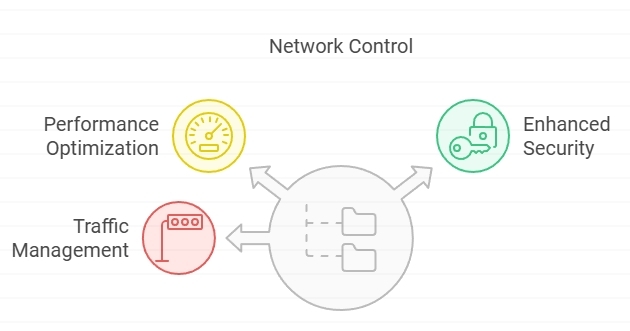
Configuration Flexibility
One thing that genuinely sets managed PoE switches apart from their unmanaged counterparts is their flexibility regarding configuration options. We can tailor the switch’s settings according to our unique requirements, ensuring that our connected devices receive optimal connectivity and resources.
For instance, if we have specific devices that require higher priority access or dedicated bandwidth, we can easily configure these settings within a managed switch. This level of customization empowers us to fine-tune our network infrastructure for maximum productivity and performance.
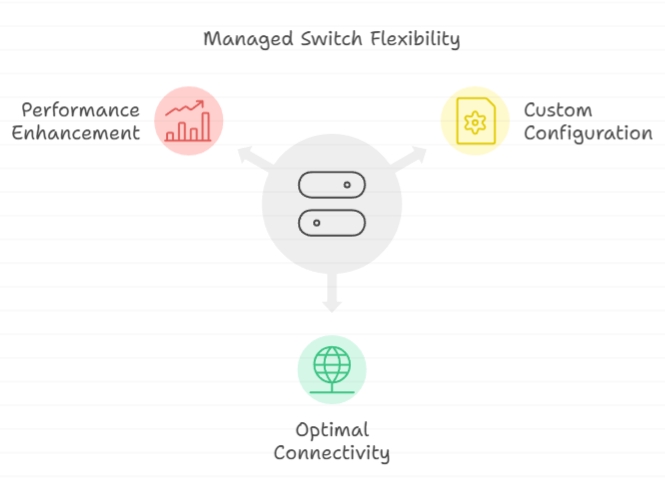
Advanced Monitoring Capabilities
Another significant advantage offered by managed PoE switches is their advanced monitoring capabilities. These switches allow us to keep a close eye on the status and activity of each port, providing valuable insights into data flow patterns and potential issues within the network.
Industrial PoE Switches: Enhancing Network Robustness
Industrial PoE Switches
Industrial PoE switches are built to endure harsh conditions and provide reliable connectivity in industrial environments. These switches boast extended temperature ranges, sturdy enclosures, and surge protection features to ensure uninterrupted operation in critical applications like manufacturing plants and transportation systems.
Industrial PoE switches perform well in harsh conditions where regular networking equipment might fail. Their rugged design allows them to withstand extreme temperatures, humidity, vibrations, and electromagnetic interference commonly found in industrial environments. For instance, a manufacturing facility with heavy machinery or a remote outdoor surveillance system would greatly benefit from the robustness of an industrial PoE switch.
The quality of service (QoS) is another vital aspect of these switches. They prioritize network traffic to guarantee that essential data, such as video streams or control signals, precede less time-sensitive information. This ensures crucial operations within an industrial setup receive the necessary bandwidth without interruption.
Benefits of Managed PoE Switches
One significant advantage of managed PoE switches is their ability to provide greater control over network traffic compared to unmanaged ones. With managed switches, we can monitor and adjust various parameters more effectively, such as bandwidth allocation and security protocols.
Moreover, managed PoE switches often offer advanced features like VLAN (Virtual Local Area Network) support for segmenting the network into multiple virtual networks. This capability enhances security by isolating sensitive devices or separating different organizational departments while efficiently managing data traffic flow.
Considerations for Deployment
When deploying industrial PoE switches, it’s crucial to consider factors such as power redundancy options and ease of management through centralized platforms. This ensures continuous operation even if one power source fails, safeguarding against costly downtime in critical applications.
Opting for centralized management solutions enables us to oversee all connected devices from a single interface—simplifying maintenance tasks while enhancing overall network visibility and control.
The Role of Managed PoE Switches in Modern Networking
Powering and Connecting IoT Devices
Managed PoE switches support the vast network of devices that comprise the Internet of Things (IoT). These switches provide power and data connectivity to various devices, including security cameras, wireless access points, VoIP phones, and more. By delivering power and data over a single Ethernet cable, managed PoE switches simplify installation processes and reduce the need for multiple power sources. This streamlined approach enhances convenience and contributes to cost savings by eliminating the necessity for additional electrical infrastructure.
The ability to remotely control power allocation is another crucial advantage managed PoE switches offer. These switches enable seamless management through centralized control interfaces in scenarios where devices need to be reset or powered down without physical intervention. This capability proves especially valuable in large-scale deployments across expansive facilities or remote locations. Moreover, it ensures continuous operation with minimal disruptions while allowing for efficient energy management.
Facilitating Network Segmentation
Network segmentation is essential for optimizing network performance and ensuring secure communication among connected devices. Managed PoE switches support this requirement by enabling administrators to create distinct virtual networks within a single physical infrastructure. VLAN (Virtual Local Area Network) configuration capabilities allow these switches to isolate specific device types or user groups based on varying requirements such as security protocols or bandwidth needs.
By segmenting the network into separate virtual LANs, managed PoE switches enhance overall network efficiency while maintaining robust security measures. For instance, surveillance cameras can operate within their designated VLAN dedicated solely to video traffic without impacting other network segments handling voice communications or data transfer tasks. This segregation minimizes potential congestion issues and significantly reduces the risk of unauthorized access between different device categories.
Enhancing Network Efficiency and Scalability
In addition to powering IoT devices and facilitating effective network segmentation, managed PoE switches significantly enhance overall network efficiency and scalability. These advanced networking solutions offer Quality of Service (QoS) prioritization, which optimizes traffic flow based on predetermined criteria like latency sensitivity or bandwidth requirements.
Furthermore, built-in monitoring tools provided by managed PoE switches empower administrators with comprehensive visibility into network performance metrics such as traffic patterns, usage statistics, error rates, and more. This real-time insight enables proactive troubleshooting efforts to swiftly address emerging issues before they escalate into critical problems that could disrupt operations.
Ultimately, managed PoE switches are indispensable components in modern networking environments due to their pivotal role in powering diverse IoT devices while enabling efficient management through network segmentation features.
Conclusion: Integrating Managed PoE Switches for Network Efficiency
We’ve delved into the realm of managed PoE switches and uncovered their pivotal role in optimizing network performance. From unraveling the intricacies of Power over Ethernet technology to dissecting the advantages of HoweVision’s offerings, we’ve gained a comprehensive understanding of how these switches empower connected devices and elevate modern networking infrastructures. As we navigate the ever-evolving landscape of technology, integrating managed PoE switches has become an option and necessary for ensuring seamless connectivity, robustness, and efficiency in our networks.
Let’s embark on this journey towards network optimization together. Whether upgrading existing infrastructure or implementing new solutions, let’s leverage the insights we’ve gained to enhance our networks and embrace the future of connectivity.
Howevision Network Management PoE Switch Recommendation
-
24 Ports 10/100/1000Base-TX Unmanaged AI PoE Switch with 2xGigabit SFP
-
16 Ports 10/100/1000Base-TX Unmanaged AI PoE Switch with 2xGigabit SFP
-
48 Ports Layer 3 managed POE switch with 4 Ports 10Gbps SFP+
-
8 Ports Gigabit Managed PoE Switch with 2 Ports Gigabit SFP
-
Gigabit Managed Ethernet Switch, 24-Ports 10/100/1000Base-TX RJ45, 4 Ports Gigabit Combo Uplink
-
Gigabit Managed Ethernet PoE Switch, 24 Ports PoE+, 4 Ports Combo Uplink
Frequently Asked Questions
What is an unmanaged switch?
An unmanaged switch is like a bare traffic cop that allows devices to communicate with each other. It operates without any configuration and doesn’t offer a managed switch’s advanced features and control.
What is a managed switch?
A managed switch, on the other hand, provides more control and flexibility. It offers features such as VLANs, QoS, and monitoring capabilities. Think of it as a sophisticated traffic controller that can direct and prioritize network traffic based on specific requirements.
How do Managed PoE Switches empower connected devices?
Managed PoE switches provide power and data connectivity to IP cameras, wireless access points, and VoIP phones. With management capabilities, these switches allow for better control over power distribution, security settings, and network performance optimization.
What are the advantages of using HoweVision Managed PoE Switches?
HoweVision Managed PoE Switches offer enhanced power management for connected devices and advanced networking features like VLAN support and Quality of Service (QoS). They ensure efficient power delivery while providing robust control over network traffic.
Why should one consider integrating Managed PoE Switches for Network Efficiency?
Integrating Managed PoE switches enhances overall network efficiency by allowing centralized control over power delivery to connected devices and providing advanced networking capabilities for optimizing data traffic flow. This results in improved performance and reliability across the network infrastructure.
